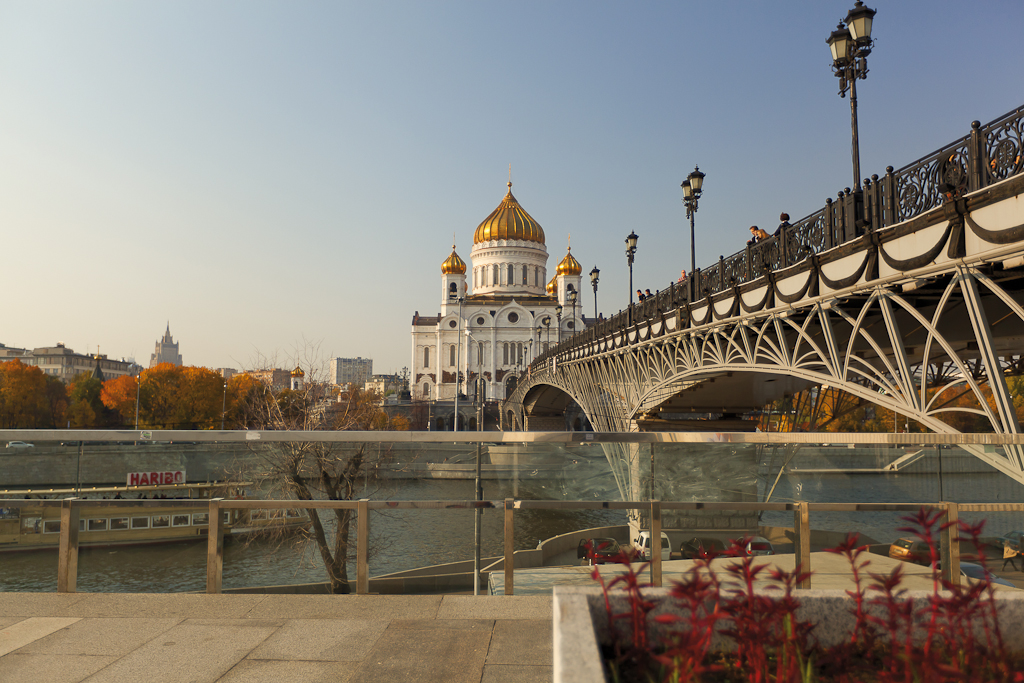The Cathedral of the Moscow diocese, and the Russian Orthodox Church. The decision to build it “in commemoration of our gratitude to Divine Providence for saving Russia from threatening to it death” was adopted by Emperor Alexander I in 1812. The temple was laid in1839 on the site of Alexis nunnery. In 1883, it was regarded as the highest building in Moscow and the biggest church in Russia. In 1931 the cathedral was blown up by order of Stalin. It was rebuilt only by the 2000 year. Shrines of the Temple: the revered icon of Smolensk Mother of God, the icon “the Saviour Almighty”, the Icon of St. Nicholas, written at Bari, the relics of Apostle Andrei Pervozvannyi.
The station has two exits. Yours is towards the Cathedral of Christ the Savior. Leaving the station you find yourselves in Volkhonka Street. Several museums are to be found here. The best-known is the Pushkin Museum of Fine Arts (to your left) founded one hundred years ago by I. Tzvetayev, the father of a prominent Russian poet Marina Tzvetayeva. The museum’ s collection boasts of 670 thousand pieces of West-European art. The collection of the works of French impressionists and post-impressionists displayed in the museum is considered to be one of the world’ s most notable.
As for us, let’ s proceed to the Cathedral of Christ the Savior. In the old times, the Moscow’ s oldest convent named Alexeyevsky was located here. In its memory the Catherdal’ s lower Church of Transfiguration was consecrated. It was already in December 1812 that the emperor Alexander I issued a decree by which he took oath to erect “ a church in the name of Christ the Savior” in Moscow as a tribute to the memory of the Napoleonic war heroes. The place for the construction was chosen up on Sparrow Hills. By force of circumstances, the erection of the cathedral started only in 1839 under the reign of a new monarch, Nicolas I, in a new location at Volkhonka Street. The construction works spread over fifty years, during which services were still ministered here. In December 1931, the Cathedral was leveled to the ground by an explosion leaving the space vacant for the construction of a monstrous 420-meter Palace of Soviets with a gigantic figure of Lenin on top. This project was never implemented, and in 1960 an open-air Moskva swimming pool was opened in the place of the demolished cathedral. Incidentally, the pool was a great attraction for Muscovites. The cathedral was re-erected in the 1990s. The first solemn liturgy was ministered here in 2000 on the Christmas night of January, 6 – 7. The cathedral can accommodate the congregation of up to 10,000 people. The cathedral complex incorporates the museum of the history of the cathedral. An elevated observation platform was installed under the cathedral’ s dome.
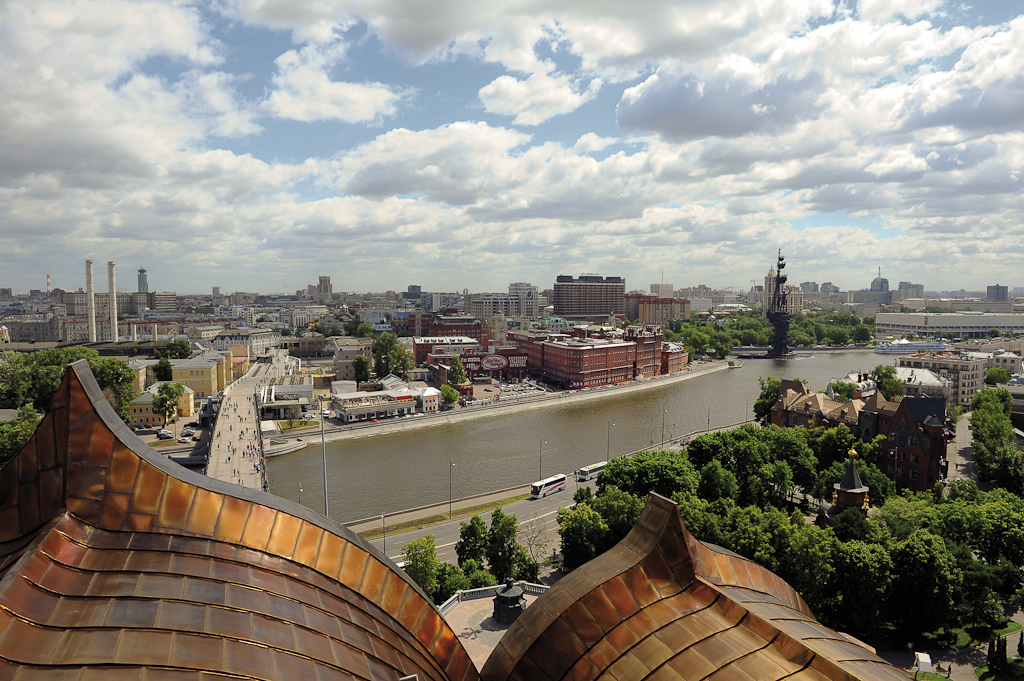
As you walk around the cathedral, you’ d find yourselves entering a pedestrian bridge across the Moskva River. It was officially called Patriarshy (Patriarch’ s) Bridge soon after Most Holy Patriarch Alexius II passed away. The view of the city center from the bridge is the most splendid. Looking to the right across Soymonovsky Passage you can notice a “ fairy-tale” house with a saddle-back roof, “ terem”-like (V-roofed) balconies and tiled faзade panels depicting the magic Sirin Bird, peacocks and Jarilo the Sun (a Proto-Slavic deity of fertility and vegetation) (1, Soymonovsky Passage). The house was built in 1907 for a Russian engineer P. Pertzov in accordance with the drafts of the artist S. Maliutin – the creator of the Russian matryoshka doll. From 1908 till 1912 the basement of the house was used as premises of the “ Bat” artistic cabaret, whose stage witnessed performances of the Moscow Art Theatre actors.
Cast a glance across the river. In ancient times the territory on this bank used to be called Sadovniky (Garden place) due to imperial gardens located here ever since the end of the XV century. What you see is one of the six large Moscow islands, this particular being hand-made. It was dumped in the XVIII century during the laying of the drainage canal.
To the left you can see the soaring colossus of the House in the Embankment with crosses of the Church of St. Nikolas in Bersenevka in the foreground glittering behind the trees. The Chambers (Palaty) of Averky Kirillov are nearby. To the right is Krasny Oktyabr (Red October), the former “ Einem” confectionary that has extended its workshops along the embankment. The odour of chocolate has always been here in the air. The “ sweet” production was recently shifted to a new location, and the factory shops were rebuilt. Today, the factory comprises a whole range of galleries, photo shops, comparatively inexpensive hostels, restaurants, bars and night clubs frequented by young people. The whole of the area is being referred to as the “ Art-spit”. The enormous monument to Peter the Great gives the finishing touch to the panorama.

The chimneys of MOGES-2, the municipal power plant, dominate the horizon. It was used as a power supply station for the Moscow tramway system. It has remained operational until nowadays. It is worth coming closer to see the ship-like building with its funnel-like chimneys.
Descend into Bersenevskaya Embankment and turn left towards the ancient “ palaty” (palace, palazzo) of the XVI century. Its first owner is unknown, however, one hundred years later it was owned by the Kirillov family. Averky KIrillov, the Duma (old-Russian parliament) clerk was the best known family member. He was killed during the “ streltzy” (regular army servicemen) uprising of 1682. In the 1650s he rebuilt the ancient edifice. Half a century later, the building was reconstructed again and ever since has not been changed. It is probably the best-preserved XVII century secular building in Moscow outside the Kremlin wall.
To the left from the “ palaty “, further in the courtyard stands the Cathedral of St. Nicolas on Bersenevka. It was accomplished in 1657 raised with the funds of the mentioned Averky Kirillov. The cathedral is unusually exquisite – architraves, plaster tiles, “ plummets” and “ melons” garnish its faзade. In Soviet times, it was turned into a warehouse and later was occupied by some scientific institutions. Since 1992 it has been an active church again.
Now, let’ s go back to the embankment. To your right is the famous “ Government House” more often called “ The House in the Embankment”. The house got the name after Yuri Trifonov’ s book, published in 1976. Trifonov lived here in the pre-war period.
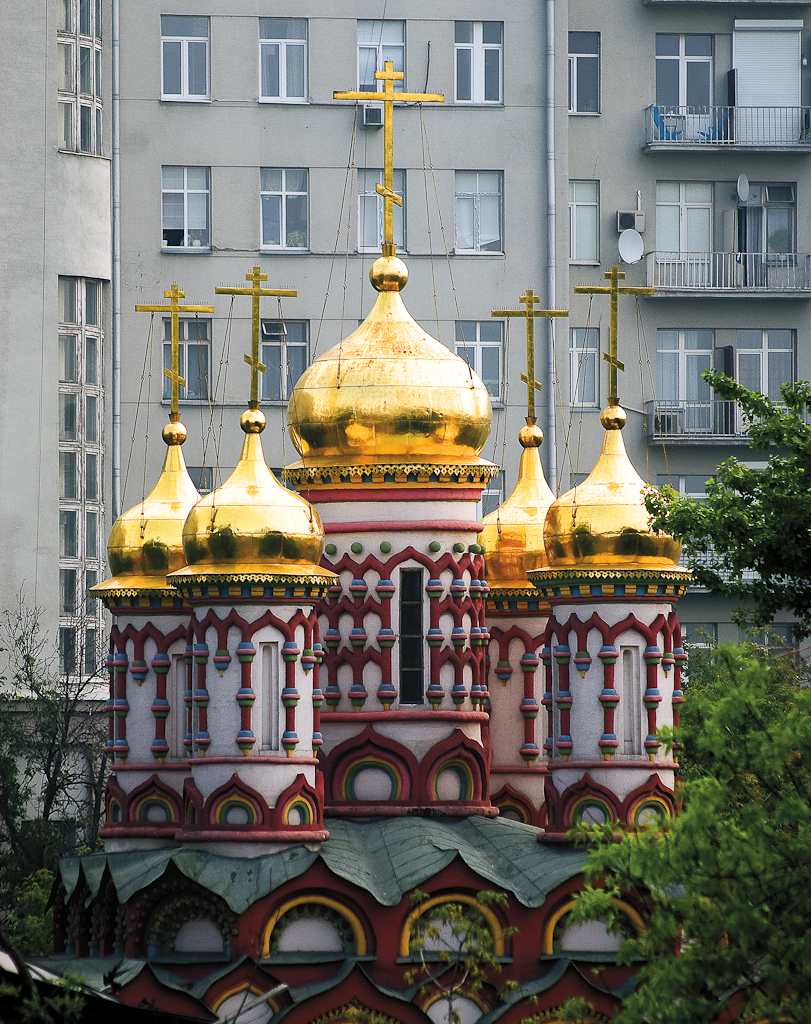
The building was designed by B. Iofan. It took four years to build it. It was erected in the place of a former salt and liquor warehouse where from the so called “ monopoly vodka” was delivered to Moscow saloons.
For a long time the house had been the biggest block of flats in Europe. In different periods of time its tenants had been six Politbureau members, sixteen Marshalls and Admirals, more than sixty Peoples’ Commissars (ministers) and their deputies as well as prominent workers of art. The faзade of the house is faced with numerous memorial plaques.
Before the war, the courtyards of the House used to accommodate fountains, a kindergarten, a preschool institution, a laundry and a club (the present-day Variety Theatre) – everything for private use of tenants. Not forgetting to mention the “ Udarnik” (shock-worker) cinema which was the largest in Europe for the time as well as the apartment house. The cinema was equipped with a sliding roof, however, this engineering device was never used due to the fear of rain and mosquitoes.
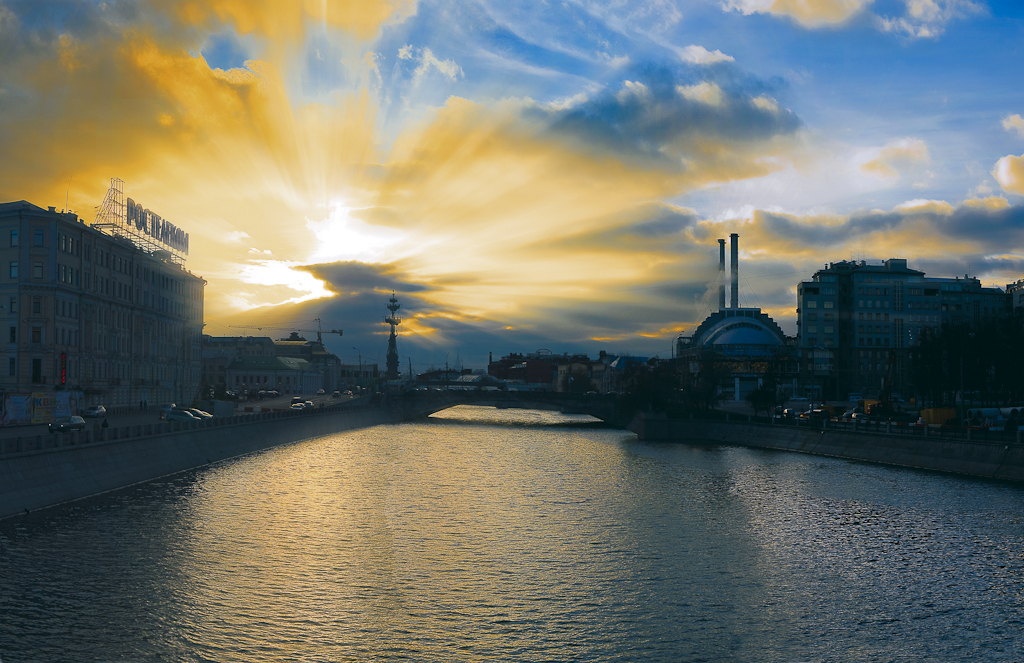
There is a museum of the House on the Embankment housed in the premises of the former commandants office (in the court next to the Variety Theatre). Take a walk through the courtyards of the house towards Serafimovicha Street named after the Soviet writer Serafimovich in 1933, who once lived here. Cross the street by a pedestrian underpass towards a five-storey apartment house (5/16 Serafimovicha Street). This house was mentioned in a poem by a popular children’ s author Agnia Barto: “ There was a house in this place, but it disappeared with all of its tenants overnight…” In fact the house did not disappear at all, however, in 1937 it was moved 74 meters aside to vacate the construction area of new Big Stone Bridge.
Passing by the “ travelling” house you enter the park at Bolotnaya (Boggy) Square.
The area around the place was marshy, hence the name of the square. The swampland was drained in the XVIII century on the order of Catherine II.
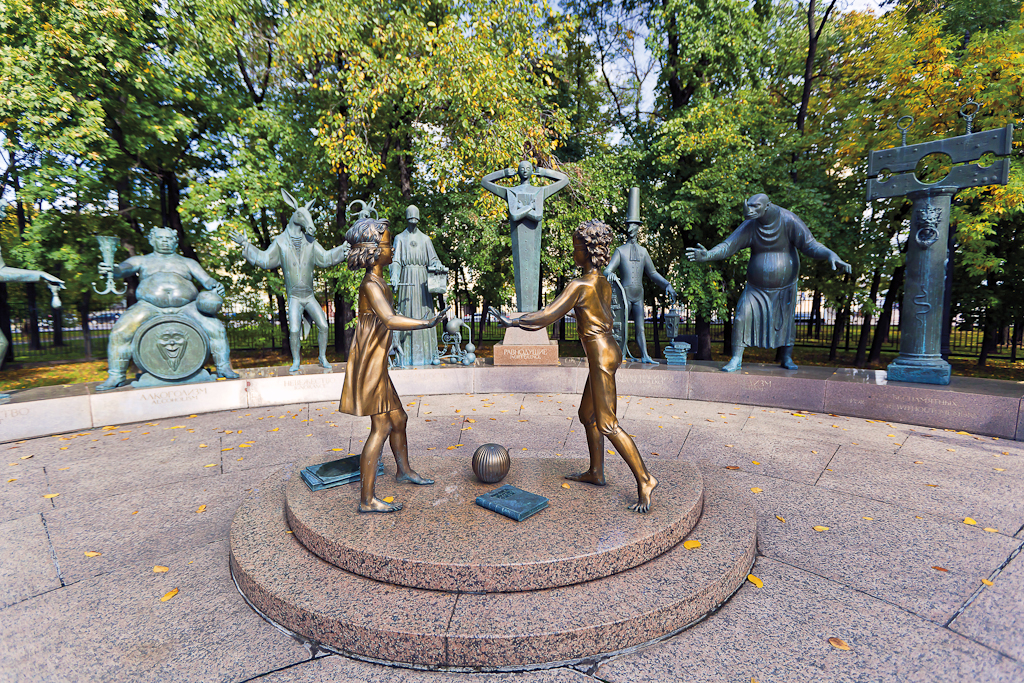
The legend has it that fist fights were organized here in XVI – XVII centuries. They were so popular that even the tzar would attend the show once in a while. The bog was also the venue of public executions and festive fireworks.
In the XIX century “ The Bog” had finally acquired the status of a peaceful trading square. In winter, the main grain market in Moscow was operating here. From summer until late fall, fruits were sold in the square. In Soviet times the trading was stopped here. In 1940 a park was placed here. In commemoration of Moscow’ s 800-th anniversary in 1947 lanterns were installed in the park, as well as flowers were planted, and a fountain was put in operation. In the course of time, a monument to the prominent Russian artist I. Repin was unveiled here. In 2001 another sculpture appeared in the park. It was a work by M. Shemyakin “ The Children — victims of Adults Vices”.
The present-day park is a popular venue for young people. At night fire poi performers congregate here. They stage real shows of “ fire dancing” swaying their poi in sophisticated bright red patterns in growing dark. Amateur drummers, guitarists and violinists are frequent visitors here as well.
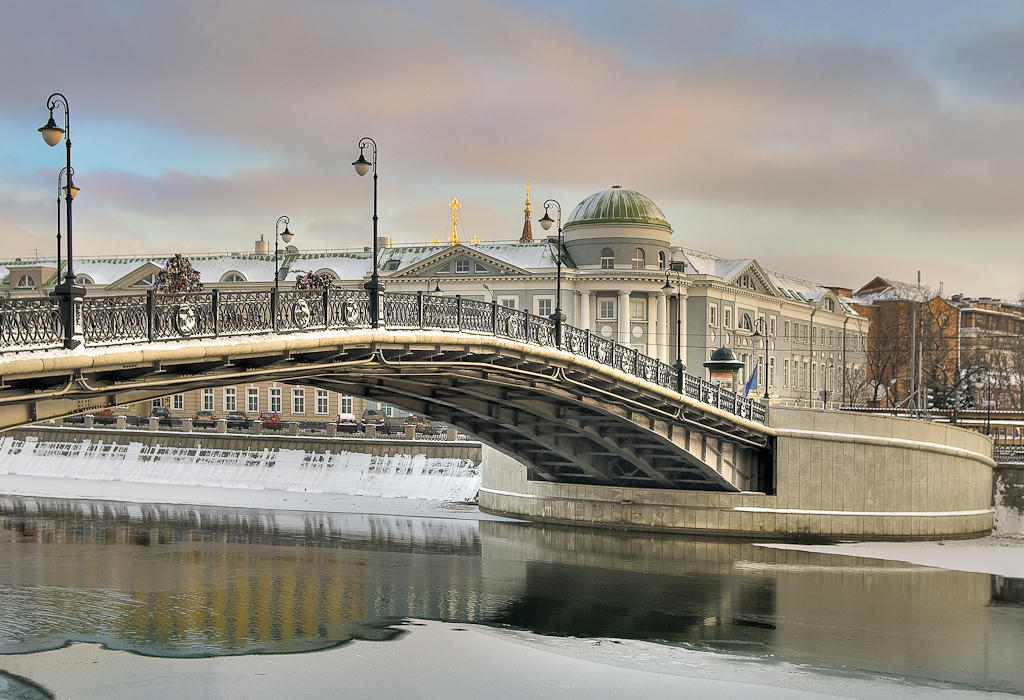
There is a Luzhkov bridge spanning the Drainage Canal. Its popular name is Love Bridge. It is the place of newly-weds’ pilgrimage. The Canal’ s embankment is always full of wedding limousines. The explanation for this notion is the fact that the first Tree of Love was installed in the bridge in 2007. Newly married couples arrived here to hang a padlock on a branch of the tree and cast the key in the waters of the Canal. By doing so they would express their wish of a long and inseparable love. As the first tree was filled up to the capacity, new trees started to appear on the bridge. At present, Trees of Love are planted alone the embankment.
It is here in Bolotnaya Square, that our tour comes to an end. The nearest Metro Station is Tretyakovskaya. To get there, you need to cross the Canal by Love Bridge and walk along Lavrushinsky Side-Street with the famous Tretyakov Art Gallery in it. A visit here may be a good final touch.
